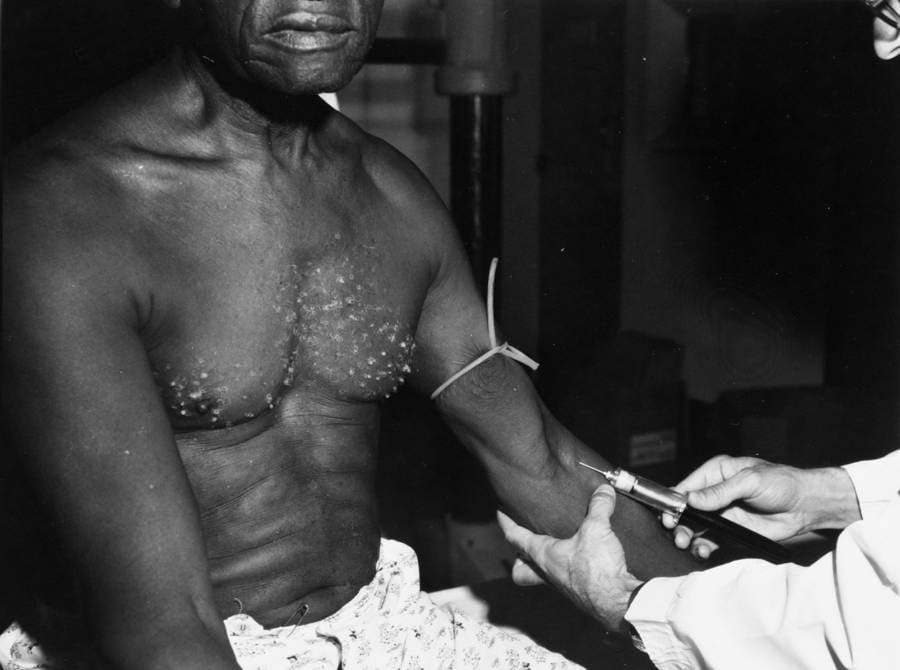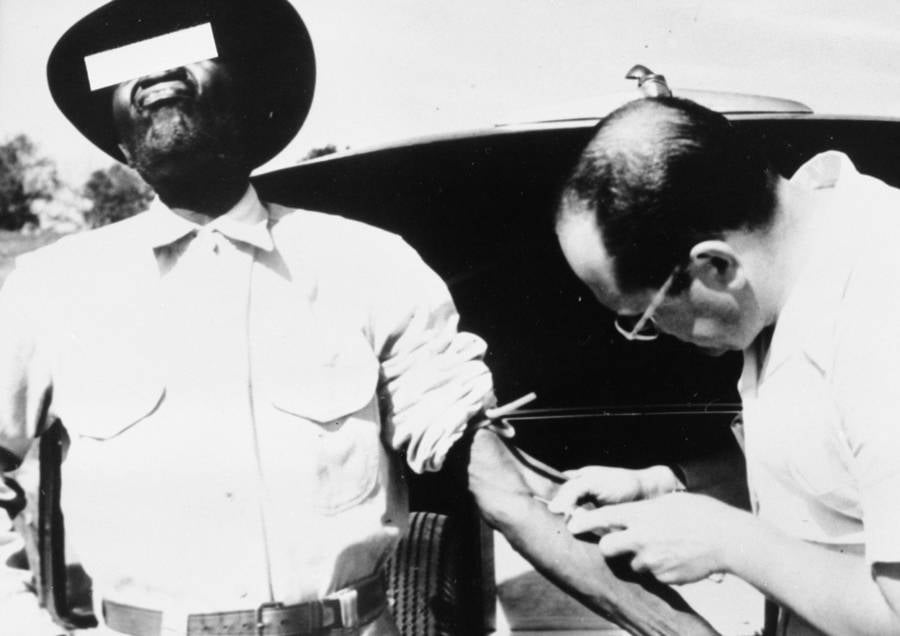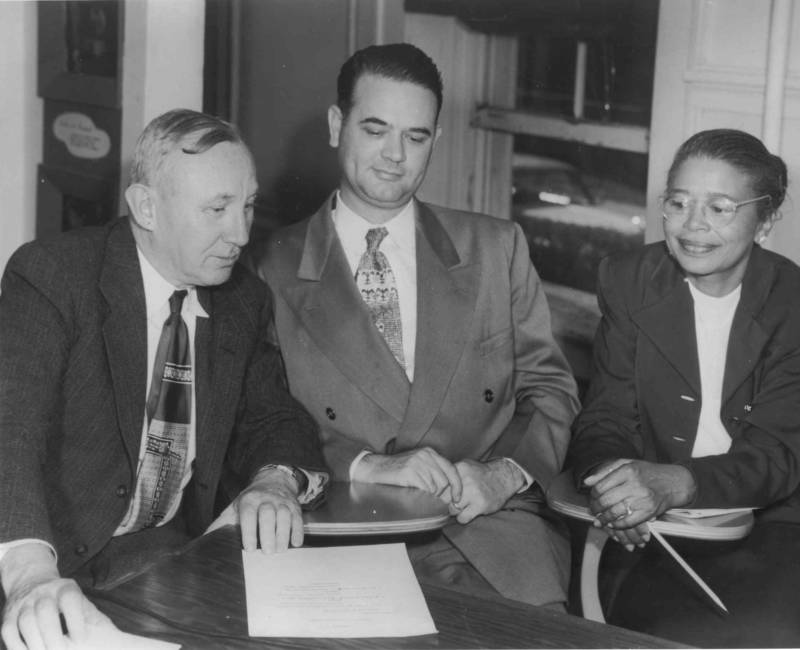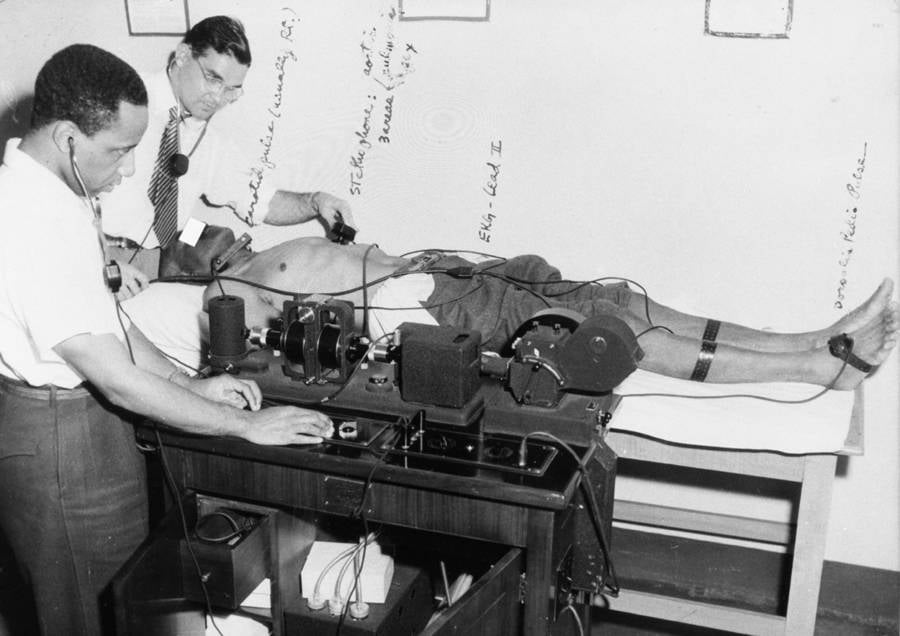From 1932 to 1972, the Tuskegee syphilis study allowed hundreds of African American men to die — all in the name of "science."
In the midst of the Great Depression, the U.S. government appeared to be giving away free healthcare to poor African American sharecroppers in Macon County, Alabama. There was a serious syphilis outbreak there at the time. And it seemed as though the government was helping to fight it.
However, it eventually came to light that the government doctors had simply allowed 600 Black men — many of whom had syphilis — to believe that they were getting free treatment for their “bad blood.”
In reality, the doctors weren’t giving them any treatment at all.
Instead, the purpose of the Tuskegee experiment was to observe untreated Black patients as syphilis ravaged their bodies — until they died.
The Beginnings Of The Tuskegee Experiment

National Archives/Wikimedia CommonsDr. Walter Edmondson taking a blood sample from an unidentified participant in the Tuskegee study. 1932.
The United States Public Health Service ran the Tuskegee experiment from 1932 to 1972. It was the brainchild of senior official Taliaferro Clark, but he hardly worked alone. Several high-ranking members of the Public Health Service were involved and the study’s progress was regularly reported to the government and given repeated stamps of approval.
Originally, the study’s directive was to observe the effects of untreated syphilis in African American men for six to eight months — followed by a treatment phase. But as the plans were being finalized, the Tuskegee experiment lost most of its funding. The challenges of the Great Depression caused one of the funding companies to back out of the project.
This meant the researchers could no longer afford to treat the patients. But instead of canceling the study, they adjusted it — in a barbaric way.
The study now had a new purpose: to see what happened to a Black man’s body if he didn’t get any treatment for syphilis at all.
Researchers thus observed the men who had syphilis until they died, offering them only placebos such as aspirin and supplements. And all the while, they lied to them about the true nature of their condition — to prevent them from seeking true medical care anywhere else.
How Doctors Deliberately Withheld Treatment From Vulnerable Patients

National ArchivesThe Tuskegee syphilis study was one of the most unethical experiments performed in U.S. history.
When the Tuskegee experiment first began, doctors already knew how to treat syphilis using arsenic therapy. But the researchers deliberately withheld information about treatment. They told the patients that they were suffering from “bad blood” to keep them from learning about syphilis on their own.
The experiment was unquestionably illegal. By the 1940s, penicillin was a proven, effective treatment for syphilis. And laws requiring treatment for venereal diseases were introduced. But the researchers defied these laws.
In fact, Dr. Thomas Parran Jr., one of the study’s leads, wrote in his annual report that the study was “more significant now that a succession of rapid methods and schedules of therapy for syphilis has been introduced.”
In short, he maintained that the Tuskegee experiment was more important than ever precisely because so many cases of syphilis were getting cured. This, he argued, was their last chance to study how syphilis killed an untreated man. And so the heinous study continued — for decades.
Four Decades Of Agonizing Deaths During The Tuskegee Syphilis Study

National ArchivesBy the time the experiment came to an end, only 74 of the test subjects had survived.
In all the years this reprehensible study was active, nobody stopped it. By the 1940s, physicians weren’t only neglecting to treat the men’s syphilis, they were also actively keeping them from finding out there was a cure.
“We know now, where we could only surmise before, that we have contributed to their ailments and shortened their lives,” Oliver Wenger, a director for the Public Health Services, wrote in a report.
But that didn’t mean he was going to stop the experiment. Instead, he said, “I think the least we can say is that we have a high moral obligation to those that have died to make this the best study possible.”
In 1969, 37 years into the study, a committee of Public Health Service officials gathered to review its progress. Of the five men in the committee, only one felt they should treat the patients. The other four ignored him.
Ethics weren’t a problem, the committee ruled, as long as they “established good liaison with the local medical society.” In other words, as long as everyone liked them, “there would be no need to answer criticism.”
The Doctors Who Allowed The Tuskegee Experiment To Happen

National ArchivesEunice Rivers poses for a photograph with two doctors involved in the Tuskegee experiment.
It’s hard to imagine anyone wanting to be associated with such a horrific experiment, let alone anyone from the historically Black Tuskegee Institute and its staff of Black doctors and nurses. But their involvement is part of the sad story behind the Tuskegee syphilis study.
In fact, the patients’ main contact point was an African American nurse named Eunice Rivers. Her patients called the observation building “Mrs. Rivers’ Lodge” and regarded her as a trusted friend. She was the only staff member to stay with the experiment for the full 40 years.
Rivers was fully aware that her patients weren’t being treated for the disease ravaging their bodies. But as a young Black nurse given a major role in a government-funded project, she felt that she couldn’t turn it down.
“I was just interested. I mean I wanted to get into everything that I possibly could,” she recalled after the experiment ended.
Rivers even justified the study after it went public in 1972, telling an interviewer, “Syphilis had done its damage with most of the people.” She also mentioned that the research provided value, saying, “The study was proven that syphilis did not affect the Negro as it did the white man.”
How The Tuskegee Syphilis Study Was Revealed To The World

National ArchivesNurse Eunice Rivers filling out paperwork in 1932. She later defended her role in the study.
It took 40 years for someone to break the silence and shut the study down. Peter Buxtun, a Public Health Service social worker, tried staging several protests within the department to stop the experiment. But when his superiors continued to ignore him, he finally called the press.
On July 25, 1972, The Washington Star ran Buxtun’s story and the next day it was on the cover of The New York Times.
Finally, it was revealed to America — and to the rest of the world — that the U.S. government had broken its own laws and experimented on its own citizens. And there was damning proof: Incriminating signatures from everyone in the Public Health Department were all over the documents.
Thus, the Tuskegee experiment finally came to an end.
Tragically, by then only 74 of the test subjects had survived. Approximately 40 of the patients’ wives had become infected, and 19 of the men had unknowingly fathered children born with congenital syphilis.
The Unapologetic Reaction From The Tuskegee Researchers

National ArchivesDoctors involved in the Tuskegee experiment with nurse Eunice Rivers.
Even after the truth came out, the Public Health Service didn’t apologize.
In fact, John R. Heller Jr., the head of the Division of Venereal Diseases, publicly complained that the Tuskegee experiment was shut down too soon and should have gone on longer. “The longer the study,” he said, “the better the ultimate information we would derive.”
Meanwhile, Eunice Rivers insisted that none of her patients resented her for her part in the study. “They love Mrs. Rivers,” she said. “In all of this that has gone on, I have never heard anyone say anything that was bad about it.”
The Tuskegee Institute apparently agreed. In 1975, three years after the Tuskegee experiment became public knowledge, the institute presented Rivers with an Alumni Merit Award. “Your varied and outstanding contributions to the nursing profession,” they declared, “have reflected tremendous credit upon Tuskegee Institute.”
But the families of the patients certainly didn’t echo the support of Rivers — and they made sure their voices were heard. “It was one of the worst atrocities ever reaped on people by the government,” said Albert Julkes Jr., whose father died thanks to the study. “You don’t treat dogs that way.”
The Aftermath Of The Heinous Experiment

National Archives Some believe that the Tuskegee experiment damaged public trust in the U.S. healthcare system.
After news of the study came out, the American government introduced new laws to prevent another tragedy like this. These new laws required informed consent signatures, accurate communication of diagnosis, and detailed reporting of test results in every clinical study.
An Ethics Advisory Board was formed in the late 1970s to review ethical issues concerning biomedical research. And efforts to encourage the highest ethical standards in scientific research are ongoing to this day.
In 1997, the U.S. government formally apologized to the victims of the Tuskegee experiment. President Bill Clinton invited the last eight survivors and their families to the White House and apologized to them directly.
He told the five survivors that attended, “I am sorry that your federal government orchestrated a study so clearly racist. That can never be allowed to happen again… Your presence here shows us that you have chosen a better path than your government did so long ago.”
The legacy of the Tuskegee experiment is without question a horrific one. Decades later, this dark chapter in American history still looms large throughout the nation. This is especially true in Tuskegee, where this real-life horror story will never be forgotten.
After this look at the Tuskegee syphilis study, find out about the disturbing Stanford Prison Experiment. Then, read up on the horrifying medical experiments carried out by Japan’s Unit 731 during World War II.





